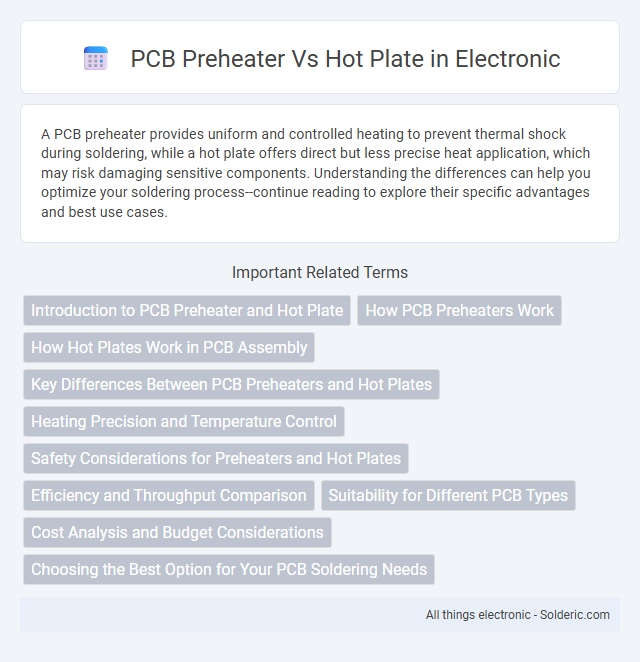A PCB preheater provides uniform and controlled heating to prevent thermal shock during soldering, while a hot plate offers direct but less precise heat application, which may risk damaging sensitive components. Understanding the differences can help you optimize your soldering process--continue reading to explore their specific advantages and best use cases.
Comparison Table
| Feature | PCB Preheater | Hot Plate |
|---|---|---|
| Primary Use | Preheating printed circuit boards before soldering | Direct heating of components or small circuits |
| Temperature Control | Precise, distributed heating with adjustable temperature zones | Localized heating with adjustable temperature, less uniform |
| Heat Distribution | Even heat across the PCB surface to prevent warping | Concentrated heat on contact area |
| Typical Temperature Range | 50degC to 250degC | Up to 350degC depending on model |
| Application | Used in surface mount technology (SMT) assembly and rework | Used for small-scale soldering, heating, or testing |
| Risk of Component Damage | Low, due to controlled and even heating | Higher, risk of overheating specific areas |
| Portability | Bulkier, usually stationary | Compact and portable |
| Cost | Higher initial investment | Generally lower cost |
Introduction to PCB Preheater and Hot Plate
PCB preheaters and hot plates are essential tools used in electronics manufacturing to ensure proper soldering and assembly of printed circuit boards. A PCB preheater uniformly raises the temperature of the board before soldering, reducing thermal shock and promoting better solder joint quality, while a hot plate provides a controlled heating surface for localized or general heating tasks. Your choice between these devices depends on the specific thermal management needs and precision required for your PCB assembly process.
How PCB Preheaters Work
PCB preheaters use controlled infrared or convection heat to gradually raise the temperature of circuit boards before soldering, ensuring uniform thermal distribution and reducing thermal shock. This preheating process activates flux and improves solder joint quality by minimizing defects such as cold solder joints and warping. Your assembly process benefits from enhanced reliability and consistency compared to using a hot plate, which offers less precise temperature control and uneven heating.
How Hot Plates Work in PCB Assembly
Hot plates in PCB assembly operate by providing direct and uniform heat transfer through a heated surface, allowing precise temperature control essential for soldering and reflow processes. They enable rapid heating of the PCB to activate solder paste without thermal shock, ensuring components are securely attached with minimal risk of damage. This method contrasts with PCB preheaters, which use convection to gradually raise board temperature, making hot plates ideal for quick, localized heating tasks in production.
Key Differences Between PCB Preheaters and Hot Plates
PCB preheaters provide uniform, controlled heating across the entire board to minimize thermal shock and ensure consistent solder joint quality, whereas hot plates offer localized heating often resulting in uneven temperature distribution. Preheaters commonly feature adjustable temperature settings with built-in airflow systems for precise thermal management, while hot plates typically rely on direct contact heating with less temperature uniformity. The choice between PCB preheaters and hot plates directly impacts reflow soldering efficiency, thermal stress reduction, and overall electronic assembly reliability.
Heating Precision and Temperature Control
PCB preheaters offer superior heating precision and consistent temperature control, utilizing advanced sensors and feedback systems to maintain uniform heat distribution across the board. Hot plates, while effective for general heating, often lack the fine temperature regulation necessary for delicate PCB components, leading to potential thermal stress or uneven soldering. Accurate temperature control in PCB preheaters reduces the risk of damage and improves solder joint reliability during the reflow process.
Safety Considerations for Preheaters and Hot Plates
PCB preheaters offer improved safety through precise temperature control and even heat distribution, reducing the risk of thermal shocks and component damage. Hot plates, while cost-effective, pose higher safety risks due to uneven heating and increased chances of overheating, burns, or fire hazards. Proper ventilation, temperature monitoring, and adherence to manufacturer safety guidelines are crucial for operating both devices safely in PCB assembly.
Efficiency and Throughput Comparison
PCB preheaters offer superior efficiency by evenly distributing heat across the board, reducing thermal stress and minimizing the risk of component damage. Hot plates typically provide localized heating, which can lead to uneven temperature distribution and longer processing times. Your production throughput improves with a PCB preheater due to faster ramp-up times and more consistent thermal profiles.
Suitability for Different PCB Types
PCB preheaters provide uniform heat distribution ideal for multilayer boards and complex assemblies, reducing thermal stress and improving solder joint reliability. Hot plates offer rapid localized heating suited for single-layer or simple PCBs but may cause uneven temperature profiles detrimental to sensitive components. Selecting between preheaters and hot plates depends on the PCB's layer count, component density, and thermal tolerance requirements.
Cost Analysis and Budget Considerations
PCB preheaters generally offer a lower upfront cost compared to hot plates, making them a more budget-friendly option for small-scale or hobbyist applications. Hot plates tend to have higher initial expenses but provide more uniform heating and better temperature control, which can reduce rework costs in high-volume production. Evaluating long-term costs such as energy consumption, maintenance, and reliability is essential to determine the most cost-effective choice for specific PCB assembly processes.
Choosing the Best Option for Your PCB Soldering Needs
Selecting between a PCB preheater and a hot plate depends on your soldering requirements, such as temperature control, size of the PCB, and heat distribution uniformity. PCB preheaters provide consistent, even heating, reducing thermal stress and improving solder joint quality, making them ideal for delicate components. Hot plates offer faster heating but may create hotspots, which can risk damage; Your choice should align with precision and reliability needed in your soldering process.
PCB preheater vs hot plate Infographic

 solderic.com
solderic.com